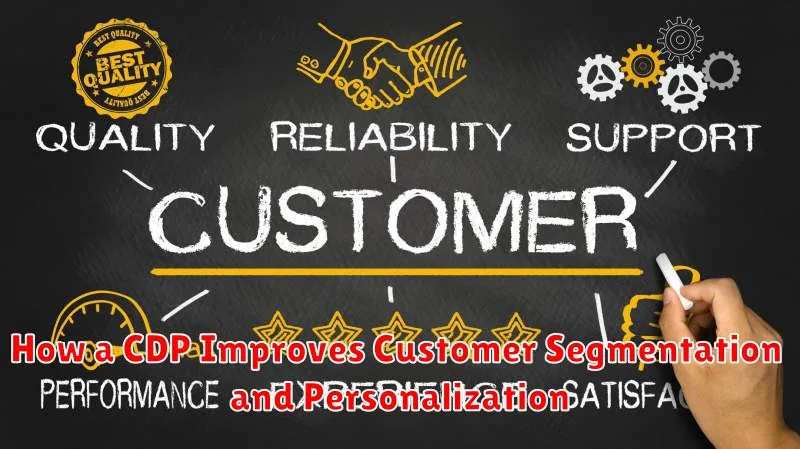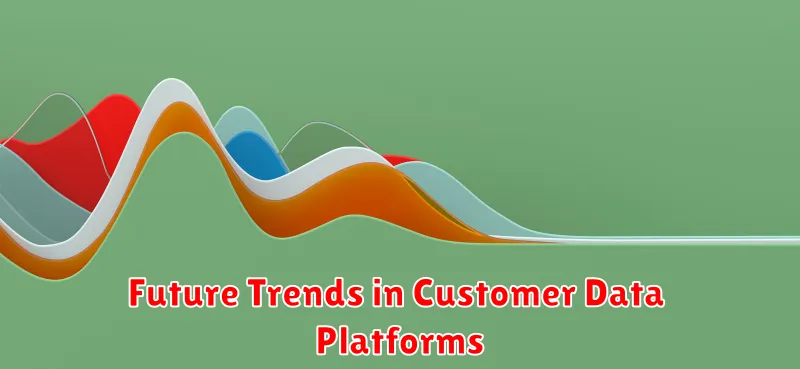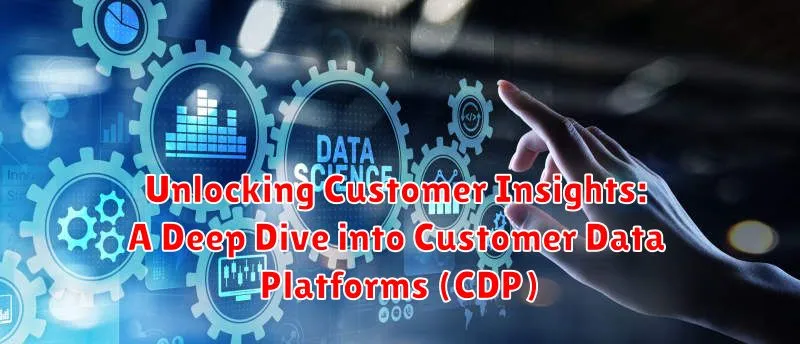In today’s data-driven world, understanding your customer is paramount to business success. Companies are increasingly turning to sophisticated tools to unlock the wealth of information hidden within their customer data. This article delves into the power of Customer Data Platforms (CDPs), exploring how they consolidate customer data from various sources to create a unified customer profile. By leveraging a CDP, businesses can gain invaluable customer insights, enabling them to personalize marketing campaigns, improve customer experiences, and ultimately drive revenue growth.
A Customer Data Platform (CDP) is more than just a database; it’s a strategic solution designed to break down data silos and provide a comprehensive view of each customer’s journey. From online interactions and purchase history to offline engagements and social media activity, a CDP collects and unifies customer data from diverse touchpoints. This unified view empowers businesses to segment their customer base, identify key trends, and tailor their offerings to meet individual needs. Our deep dive into CDPs will uncover the core functionalities, benefits, and implementation strategies for organizations looking to harness the power of their customer data.
What is a Customer Data Platform (CDP)? A Comprehensive Definition
A Customer Data Platform (CDP) is a packaged software that creates a persistent, unified customer database accessible to other systems. It aggregates data from various sources to build a single, coherent view of each customer. This unified profile can then be used to personalize marketing efforts and improve customer experience across all channels.
Unlike other data management tools, a CDP is primarily managed by the marketing team, enabling them to orchestrate personalized customer journeys. The key characteristic of a CDP is its ability to resolve identities across different data sources, ensuring a single, consistent customer view.
Here’s a simple breakdown:
- Collects: Gathers data from multiple sources.
- Unifies: Creates a single customer profile.
- Activates: Makes data available to other systems for marketing and customer service purposes.
The Core Components of a CDP: Data Collection, Unification, and Activation
A Customer Data Platform (CDP) operates on three fundamental components: data collection, data unification, and data activation. Each component is critical to the effective functioning of the platform.
Data Collection
This involves ingesting data from various sources, both online and offline. This data can include:
- Website activity
- Mobile app usage
- CRM data
- Email interactions
- Social media engagement
- In-store transactions
The CDP must be able to handle structured, semi-structured, and unstructured data.
Data Unification
Once collected, the raw data is transformed and unified to create a single, coherent view of each customer. This process includes:
- Identity resolution (matching and merging customer profiles)
- Standardization and cleansing of data
- Creation of a persistent, unified customer profile
Data Activation
The unified customer profiles are then made available for use across various marketing, sales, and customer service channels. This activation allows for:
- Personalized marketing campaigns
- Targeted advertising
- Improved customer service interactions
This activation empowers businesses to deliver relevant and timely experiences to customers across all touchpoints.
Benefits of Implementing a CDP for Your Business
Implementing a Customer Data Platform (CDP) offers numerous advantages for businesses seeking to enhance customer relationships and drive growth.
One key benefit is improved data accuracy and completeness. By centralizing customer data from various sources, a CDP eliminates data silos and ensures a single, unified view of each customer.
A CDP enables enhanced personalization. By understanding individual customer preferences and behaviors, businesses can deliver targeted marketing messages and personalized experiences, leading to increased engagement and conversion rates.
Furthermore, a CDP facilitates more effective marketing campaigns. With access to comprehensive customer data, marketers can segment their audience more precisely and tailor their campaigns to specific customer segments, resulting in higher ROI.
Finally, implementing a CDP can lead to improved customer service. By providing customer service representatives with a holistic view of each customer’s interactions, a CDP enables them to provide more personalized and efficient support, leading to increased customer satisfaction and loyalty.
CDP vs. DMP vs. CRM: Understanding the Key Differences
While Customer Data Platforms (CDPs), Data Management Platforms (DMPs), and Customer Relationship Management (CRM) systems all handle customer data, they serve distinct purposes.
A CRM focuses on managing interactions with existing customers, primarily for sales and service purposes. It tracks interactions and manages the customer lifecycle.
A DMP is primarily used for advertising and marketing efforts. It collects anonymous third-party data for targeted ad campaigns and audience segmentation, often focusing on cookie-based identification.
In contrast, a CDP aims to create a unified, persistent view of the customer by collecting and integrating first-party data from various sources, both online and offline. This unified profile is then used for personalized marketing, improved customer experience, and other business functions. The primary focus is known, identified customers.
In essence, CRMs manage customer relationships, DMPs target anonymous audiences for advertising, and CDPs unify customer data for holistic business use.
How a CDP Improves Customer Segmentation and Personalization

A Customer Data Platform (CDP) revolutionizes customer segmentation and personalization by providing a unified and comprehensive view of each customer. Unlike traditional methods relying on fragmented data, a CDP aggregates data from various sources, creating enriched customer profiles.
Here’s how a CDP enhances these crucial areas:
- Enhanced Segmentation: With a 360-degree customer view, businesses can create more granular and accurate segments based on demographics, behavior, purchase history, and engagement patterns.
- Improved Personalization: Understanding individual customer preferences allows for personalized marketing messages, product recommendations, and customer service interactions.
- Data-Driven Insights: A CDP provides valuable insights into customer behavior, enabling businesses to tailor their strategies and campaigns for optimal results.
This leads to improved customer engagement, increased conversion rates, and stronger customer loyalty.
Data Sources for Your CDP: Integrating Online and Offline Data
A Customer Data Platform (CDP) thrives on diverse data inputs. To create a comprehensive customer view, integrating both online and offline data sources is critical.
Online Data Sources
These sources capture digital interactions and behaviors. Examples include:
- Website Analytics: Data from platforms like Google Analytics, tracking page views, session duration, and bounce rates.
- Marketing Automation Systems: Email opens, click-through rates, and form submissions.
- Social Media: Engagement metrics, profile data, and social listening insights.
- E-commerce Platforms: Purchase history, browsing behavior, and product reviews.
- Mobile Apps: In-app activity, location data (with consent), and push notification responses.
Offline Data Sources
These sources provide insights into customer interactions outside the digital realm:
- CRM Systems: Customer contact information, purchase history, and support interactions.
- Point-of-Sale (POS) Systems: In-store purchases, transaction details, and loyalty program data.
- Call Center Data: Call logs, customer service interactions, and feedback surveys.
- Direct Mail Campaigns: Response rates and demographic data linked to physical addresses.
By seamlessly integrating these disparate data sources, a CDP enables a unified and holistic understanding of the customer journey.
Use Cases for CDP: Enhancing Marketing, Sales, and Customer Service
A Customer Data Platform (CDP) offers a multitude of use cases across various departments. In marketing, CDPs enable hyper-personalization of campaigns, leading to increased engagement and conversion rates. This includes targeted email marketing, dynamic website content, and personalized ad experiences.
For sales teams, CDPs provide a unified view of the customer journey, allowing for more informed and effective interactions. Sales representatives can access comprehensive customer profiles, including past purchases, website activity, and support interactions, to tailor their approach and close deals more efficiently.
In customer service, CDPs empower agents with a 360-degree customer view, enabling them to resolve issues quickly and effectively. By understanding a customer’s history and preferences, agents can provide personalized support experiences, leading to increased customer satisfaction and loyalty.
Ultimately, a CDP facilitates a more cohesive and customer-centric approach across the entire organization, driving improved business outcomes.
Choosing the Right CDP: Key Considerations and Features
Selecting the right Customer Data Platform (CDP) is crucial for maximizing its value. Several key considerations should guide your decision-making process.
Key Considerations
- Business Needs: Align the CDP’s capabilities with your specific business objectives, such as improving customer retention or increasing marketing ROI.
- Data Sources: Ensure the CDP can seamlessly integrate with all your existing data sources, both online and offline.
- Scalability: Choose a platform that can scale with your business growth and increasing data volumes.
- Integration Capabilities: The CDP should easily integrate with your existing marketing automation, CRM, and other business systems.
- User-Friendliness: Opt for a platform with an intuitive interface that is easy for your team to use and manage.
- Vendor Support: Evaluate the vendor’s reputation, customer support, and training resources.
Essential Features
- Data Ingestion & Unification: Ability to collect and unify data from diverse sources.
- Identity Resolution: Accurately identify and match customer profiles across different touchpoints.
- Segmentation & Personalization: Tools for creating targeted customer segments and delivering personalized experiences.
- Real-Time Data Processing: Capabilities for processing and activating data in real-time.
- Analytics & Reporting: Features for analyzing customer data and measuring the effectiveness of marketing campaigns.
- Security & Compliance: Robust security measures and compliance with data privacy regulations.
Data Privacy and Compliance in CDP Implementation
Implementing a Customer Data Platform (CDP) necessitates a rigorous focus on data privacy and compliance with relevant regulations. Companies must adhere to laws such as the General Data Protection Regulation (GDPR), the California Consumer Privacy Act (CCPA), and other global privacy standards.
Key considerations include obtaining explicit consent for data collection and usage, providing transparency about data practices, and enabling individuals to exercise their rights to access, rectify, and erase their personal data. Data security measures, such as encryption and access controls, are crucial to protect sensitive information from unauthorized access and breaches.
Organizations should establish clear data governance policies and procedures to ensure compliance and maintain customer trust. Regular audits and assessments can help identify and address potential vulnerabilities.
Future Trends in Customer Data Platforms

The Customer Data Platform (CDP) landscape is rapidly evolving. Expect to see a greater emphasis on real-time data processing, allowing for immediate personalization and responsiveness. Artificial intelligence (AI) and machine learning (ML) will become increasingly integrated for advanced analytics and predictive modeling, enabling more accurate customer segmentation and behavior prediction.
Enhanced data privacy features and adherence to evolving regulations will be paramount. CDPs will need to provide robust data governance tools and transparency to maintain customer trust and ensure compliance. Furthermore, expect greater emphasis on composable CDP, which allow modular integrations to optimize the overall architecture.
Interoperability with other marketing and advertising technologies is also crucial, fostering a more unified and streamlined marketing ecosystem. This shift emphasizes data-driven decision-making across the entire customer journey.

